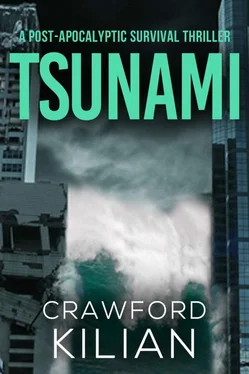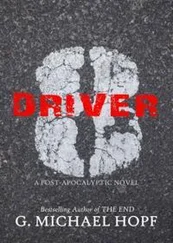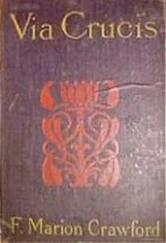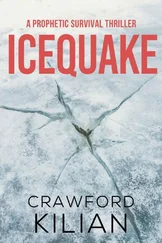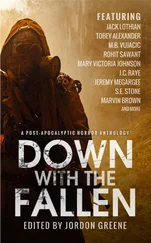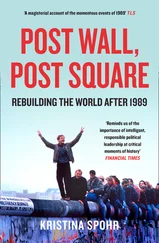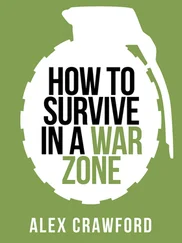Standing up, Kirstie signalled to two black women standing in the school’s main doorway. They came over, lifted Susan Smith’s body onto a stretcher, and carried it around the building to the growing pile of corpses.
Kirstie went into the school for a drink of water. The halls and classrooms were filled with more people, mostly children, awaiting emergency surgery. Some cried out and wailed, but most were strangely quiet, even those who lay by themselves along the side of the main corridor. Above them, on the walls, were construction-paper murals of tulips and raindrops; in the middle of the floor was a thick trail of mud and blood.
Someone was screaming in the cafeteria, now being used as an operating room. A young medical student in jeans and a blood-spattered apron came out of the cafeteria and looked around. He saw Kirstie and waved her over.
“Doing anything important?”
“Not really.”
“Okay, you can go to this address.” He ripped a paper tulip from the wall and scrawled on it. “It’s a medical-supplies warehouse. Grab all the sulfa drugs and dressings you can carry. Somebody brought in some backpacks, okay, I think they’re behind the reception desk up in the school office. Fill ‘em up.”
“How do I get into the warehouse?”
“Uh, you may have to break in, okay, but we need the stuff. You’ll find the dressings in big boxes near the rear door. The drugs are in a locked room between the warehouse and the front office. The key to the room should be in the top right desk drawer in Ken Berkowitz’s office, okay, with a red Dymo tape on it.”
The young man turned and pushed through the swinging doors back into the cafeteria. Fluorescent lights, powered by a portable generator, glared over a dining table where four men held down a writhing, shrieking girl while a fifth man bandaged her arm.
“Oh, and morphine, okay?” added the young man over his shoulder.
“O-kay,” Kirstie murmured, feeling both relief and guilt at escaping from the schoolyard. She found the backpacks, by a cupboard containing a flashlight; if she had to go into a darkened building, the light would be useful. Going outside, she looked around for Sam and Einar, and spotted them by their yellow ponchos.
“I need you two,” she said. They followed her out of the schoolyard and down Francisco Street.
“Where are we going?” Sam asked. She told him; he whistled.
Walking across San Pablo and down to University was easy enough; the waves had been less than knee-deep when they reached San Pablo, and had left only a scatter of rubble. But the farther west they walked down University, the harder it became. Most buildings had collapsed into piles of masonry and splintered wood. Cars were tumbled and scattered, their interiors packed with mud, across streets and sidewalks and parking lots. The Southern Pacific Railway station, an old tile-and-stucco landmark, had vanished; where the building had stood, a derailed train lay toppled on its side.
The streets were swamps; in some places, the asphalt had been torn off and the underlying gravel scoured out, leaving waist-deep gullies. Fires burned in the ruins. A hotel, big and massive enough to have survived the waves, was now only a smoking shell.
Kirstie and Sam and Einar were not the only ones floundering through the rubble. Dozens of people were picking over the remnants of jewellery and grocery stores, or wandering aimlessly. One old man, in a long overcoat and mud-caked trousers, carried a new waffle iron in a string bag as he high-stepped through the mud.
“No cops,” Sam said as they paused beside an overturned Chevy pickup. “Where the hell are the cops?”
“Some are taking people to the hospitals,” Kirstie answered. “I think a lot of them with families just took off for home. I don’t blame them. We had some firemen working across San Pablo, but they all left in a mad rush — something about a chlorine spill in Oakland.”
Sam touched her arm. “Are you serious?”
“Well, of course.”
“How big would a chlorine spill have to be, to draw firemen away from this?”
“Pretty big.”
Through a gap in the smoke overhead, a helicopter chattered south at low altitude. “Bloody television,” Kirstie muttered. “They were circling around the school like vultures this afternoon, but would they land and help? Now they must be looking for something even worse.”
“Is that where we go?” asked Einar, pointing to a two-story cement-block building half a block away.
“I think so.”
The front entrance was buried behind drifts of twisted metal and shattered wood, including a part of a sailboat’s hull. Carefully, they worked their way through the adjoining parking lot to a side entrance. It was a glass door and had been smashed open.
“Looks like someone got here before us,” said Sam quietly. He rubbed his beard. “A building full of drugs. Mmmh.” He looked at Kirstie. “I think you maybe ought to stay put until we check out the inside.”
“Don’t be so bloody chivalrous, Sam.” Kirstie got the flashlight out of her backpack and stepped through the aluminium doorframe. Water was ankle-deep inside. The entry led up two steps to a corridor; she squelched up and found it lined with offices, most of them unlocked.
Sam and Einar followed her in. The three of them moved slowly; their only illumination was from the flashlight, throwing a restless yellow ellipse on floors and walls. After looking into the first office, Kirstie turned to Sam and whispered in his ear:
“Someone’s been in here, all right. Maybe they’re still here.”
The office had been ransacked: desk drawers ripped out, house plants knocked over, filing cabinets dented. Kirstie swung the flash around, and changed her mind: not ransacked, just vandalized by someone feeling very frustrated. Maybe the key to the drug room would still be in Ken Berkowitz’s desk.
That office was two doors up the hall. It hadn’t been touched. The desk looked as if its owner had just stepped out a moment before; papers were strewn over the desk, and a brown-paper lunch bag sat beside colour photos of two small girls and their attractive mother.
The key with the red Dymo tape was easy to find. Kirstie took it and went out into the hall, where Sam and Einar were waiting. She patted Sam’s arm and went on down the hall to the locked door of the drug room.
Someone had obviously tried to break into it, using a hammer: the grey paint on the steel door was chipped away in little circles and crescents. Silently, Kirstie unlocked the door. Warm, stale air puffed out.
It didn’t take long to find the sulfa; the morphine, though, seemed to be in a padlocked cupboard.
“What now?” Kirstie hissed.
“Wait,” said Einar. He took the padlock in one big hand, and tugged at it. Then, gripping it with both hands, he put one foot up on the steel door of the cupboard and pulled.
Something snapped metallically. Einar grunted and pulled again, twisting. The hasp came away from the door, and he pitched backward across the room.
“Jesus Christ,” said Sam. “Did you know you could do that?”
“I think maybe I can do it. No harm to try.”
They were talking normally now, relieved and surprised, as they took box after box of morphine and methadone ampoules out of the cupboard.
“My God,” Sam chuckled. “If we’d done this two days ago, Einar and I could’ve retired to Rio. Son, you’re wasted in astrophysics. You should’ve been a burglar.”
“Fuckin’ A,” said an unfamiliar voice. Then, unnecessarily: “All right, everybody freeze.”
Kirstie saw Einar spin round, and heard a thump. The intruder cried out. Another thump followed, and then a second voice yelled out incoherently.
She swung her flashlight to the doorway. Lying in the hall was a young man with blood on his lips. Just beyond him was Einar’s broad back. The Icelander turned, holding another young man in a half nelson.
Читать дальше
